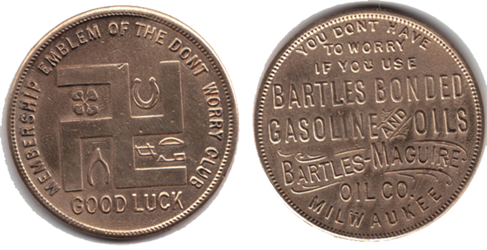 i’ve mentioned hobo nickels before, but i figured i’d give you an idea of how they are made, since one of the first things everybody says to me when i give them one is “oh, did you make this?”
i’ve mentioned hobo nickels before, but i figured i’d give you an idea of how they are made, since one of the first things everybody says to me when i give them one is “oh, did you make this?”
this is how i made them. enterprising people among you who may not be willing to risk my not giving you a hobo nickel myself (which, itself, is, actually, fairly rare) can use these instructions to make your own, with the full and complete assurance that i don’t care, although i do think that anybody who goes through this much effort for such little actual payback is kind of loopy.
also, i apologise in advance for the poor quality photos: it is difficult to use a hand to steady the camera and take pictures when you have to use two hands to hold up the tool and the piece you’re working on, so that the light shows through the kerf just right… look at it this way: 50 years ago, you wouldn’t have photographs this good, and 100 years ago there wouldn’t be any internet to read this on, so the poor quality photos are pretty good in comparison.
1) get a jewelers’ saw, a good supply of #2 or finer blades, a hand-vice, and a whole bunch of nickels. the newer and cleaner the nickels are, the better the end result will look, but it really doesn’t matter. #2 blades are fine enough that they will cut without jamming, but remove material at an acceptable rate. larger blades remove more material, but they also break more easily and don’t twist as well. finer blades don’t remove as much material, but they offer more control, especially in tight corners, although they break way more easily, and don’t last as long.
2) get a solid workspace, with a way to solidly anchor a hand-vice. i use my bench vice with the jaws separated about 2 inches, and hold the hand-vice so that the jaws stick out over the end of the bench-vice jaws. adjust the hand vice so that the nickel slides in easily, and can be gripped easily, but releases when you release the hand-vice. this is important because when you are cutting, you have to adjust the orientation of the nickel without putting the saw down, which would require an extra hand with which human beings are not, sadly, equipped.
also, i work sitting down, but which ever way for you is most comfortable to work, be prepared to take breaks, because cutting is exacting work.
3) drill a hole in the nickels with a drill bit that is small enough that it leaves both the bust of jefferson, and the edge:  this is the place where you insert your #2 saw blade, before you clamp it into the saw… yes, you cut the background out from the inside… ingenious, isn’t it? 8)
this is the place where you insert your #2 saw blade, before you clamp it into the saw… yes, you cut the background out from the inside… ingenious, isn’t it? 8)
4) cut all the way around the bust of thomas jefferson as close as you can, hopefully without cutting into thomas jefferson, or giving him weird facial appendages… unless, of course, you want to make the writer of our declaration of independence into a deformed frog-elephant. if that’s what you want, i have no control over what you do, and, as i said before, i truly don’t care…
5) this is the difficult part: when you have cut all the way around the bust of jefferson, go back to the original hole, and cut around the inside of the nickel. the reason why you do this isn’t immediately obvious, but once you’ve tried to cut around the inside of the nickel from the other side, you’ll know why. basically, it’s because you have to have some way of stabilising the nickel while you’re cutting, and if you start from the other side, all you have is the rim of the nickel, which isn’t very much, especially when you start cutting it out. the only way to avoid this is to be ambidexterous enough that, when the time comes, you can just switch hands (which, obviously, means re-orienting the hand-vice as well) and do it right handed. if you can do that, then you can ignore this step, but even before my brain injury, when i really was ambidexterous enough to do that, i still couldn’t get beyond taking a few strokes with the saw and having to replace the blade because i broke it again…
 |
 |
6) rejoice, ’cause you’ve done it too!
be prepared to break A LOT of #2 saw blades getting started… for that matter, be prepared to break one or two blades per nickel for a while. it’s tough getting your fingers trained to cut in the right place without twisting or flexing the saw enough that the blade breaks. fortunately, they’re not expensive. 😉














